<駐在員コラム>【インド】 インド人スタッフが日本のRTDレモンサワーを試飲~インド人に好まれるテイストとは?
- 公開日:2024/05/01
- 6996 Views
関連記事:
<駐在員コラム>【インド】インド人スタッフが日本のRTDサワーを試飲~インド人に好まれるフレーバーは? 第2弾
ここ数年、日本ではレモンサワー市場が活性化しており、RTD市場の約半数がレモンフレーバーとも言われている。その日本のレモンサワーに対してインド人はどのような評価をするのか、当社のインド人スタッフを対象に座談会形式で試飲を行った結果から、インド人に好まれるレモンサワーのテイストを考察する。
インドのアルコール飲料市場
座談会に入る前に、インドのアルコール市場概要についてふれたい。インドは、アルコール飲料市場が急速に成長している国の一つである。 ICRIER(※1)によると、2020年の市場規模は約525億米ドルと推定されており、2020年から2023年にかけての年平均成長率(CAGR)6.8%と予測されている。そして、2005年に2億1,900万人だったインドのアルコール消費人口は、2018年には2億9,300万人にやや増加した(ICRIER(※1))。一方で、一人当たりのアルコール消費量は2005年の2.4リットルから、2019年には4.9リットルへと倍増しており(World Bank Open Data(※2))、この一人当たりの飲酒量増加が、インドアルコール市場の成長を牽引している。
図1はアルコール飲料の販売構成比を示している。最も消費されているのはインド産洋酒(IMFL:インドで瓶詰めされたウイスキー、ウォッカ、ラムなど洋酒類)で、次にカントリーリカー(インド国内で生産される安価な地酒)、3番目にビールがあげられる。これらの3種類で、インドのアルコール消費量のほとんどを占めている。IMFLは、輸入酒と比べて税金が安く、そのため外国企業は輸入酒およびIMFL両方を販売するなどの戦略をとっている。
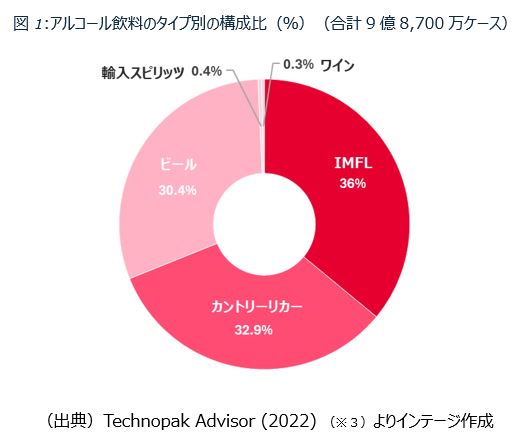
そして、インドにおけるウイスキー人気は非常に高く、インド地場で生産されるウイスキーから、スコッチ・バーボン・ジャパニーズなどの輸入品まで幅広く楽しまれており、2022年には販売されたアルコール飲料3億6,750万ケースのうち、2億4,200万ケースがウイスキーによる販売であったと、Times of India (TOI) (※4) が2023年に報じている。
インド州別のアルコール飲用率
Ministry of Health & Family WelfareのNational Family Health Survey (2019-21) (※5)によると、インド全土での飲酒率は、男性18.8%、女性1.3%であった。しかし、州によって法律が大きく異なるため、飲酒率も州によって大きく異なる。同報告書に掲載されている14の州と連邦直轄領のうち、最も飲酒率が高いインド北東部のアルナチャル・プラデシュ州では、男性は52.7%、女性は24.2%だった。その一方で、最も低いラジャスタン州では、男性の飲酒率は11%、女性は0.3%であった。また、グジャラート州のように原則酒類の販売が禁じられている禁酒州もある。このように、州によって飲酒率に大きな差がみられるのがインドの特徴となっている。
インドでのお酒販売の様子
近年、お酒の需要が伸びているインドだが、どのような種類のお酒が実際に販売されているのかを確認するために、筆者はローカルリカーショップと大型リカーショップを訪れてみた。
ローカルリカーショップ
ローカルリカーショップは取り扱っている商品は多くないものの、絶えず人々で賑わっており、来店客の多くは紙パックのウイスキーやラムをよく購入していた。
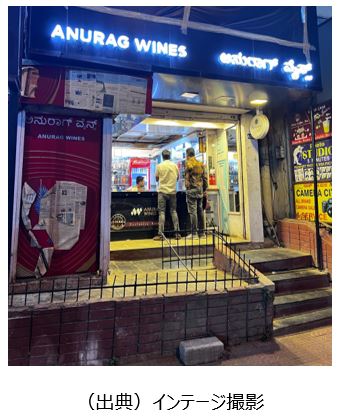
大型リカーショップ
店内は非常に広く、ワイン、ビール、スピリッツなど数多くの酒類が国産のものから外国産のものまで取り扱われており、山崎や響といった日本のウイスキーなども取り扱っていた。
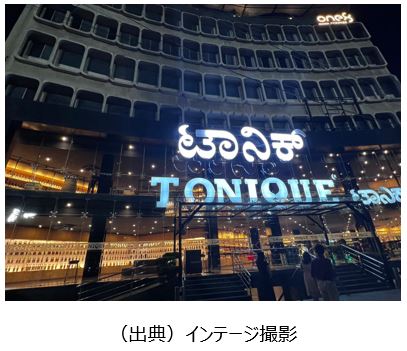
大型ショップで販売されていたRTDアルコール飲料
下の写真は、RTDアルコール飲料の一例である。瓶タイプの商品が多く、販売されている種類は、モヒート、オレンジやレモネードなどのフルーツベースのカクテル、ウォッカベースのカクテルが多い。アルコール度数は5%以上のものがほとんどで、8%などアルコール度数高めのものも多く見られた。ただ、日本のコンビニやスーパーと比べると種類・ブランドは限られており、選択肢が限られているのが現状のようだ。
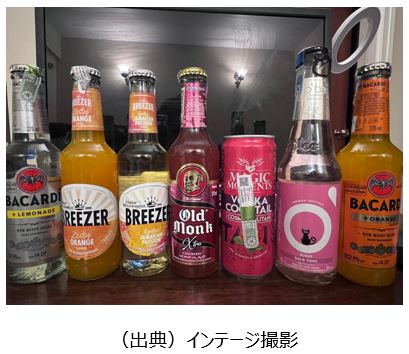
日本のレモンサワーをインテージ・インド人スタッフが試飲。その反応は?
では、当社のインド人スタッフが日本のレモンサワーを試飲した際の反応を見ていきたいと思う。今回、試飲したレモンサワーはこちらの4商品:
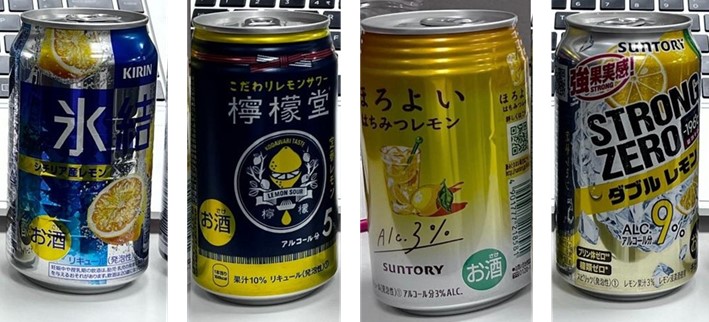
1. 氷結 シチリア産レモン
2. 檸檬堂 定番レモン
3. ほろよい はちみつレモン
4. ストロングゼロ ダブルレモン
参加スタッフのプロフィール
Rさん:本座談会唯一の女性スタッフ(30代)。月に数回お酒を飲んでおり、普段はワインやバカルディブリーザー 、カクテルを飲むことが多い。普段お酒を飲む場所は、レストランが多いが、頻繫に飲むわけではなく、お祝いの時や友達・親戚・同僚と出かけた時に限られるとのこと。
Pさん:40代男性スタッフ。月に数回程度お酒を楽しんでおり、ほとんどビールしか飲まない。友達、同僚と一緒にバーなどに飲みに行くことが多い。一人で飲むことはほとんどなく、グループでお酒を楽しむことが多い。
Mさん:20代男性スタッフ。月に数回お酒を飲んでおり、ビールが多い。普段よくお酒を飲む場所は、レストランが多く、週末に友達と一緒に楽しむことが多いとのこと。
Sさん:30代男性スタッフ。週に数回飲むとのことで、今回参加スタッフの中ではお酒を飲む頻度が一番高い。ビールをよく飲むとのこと。同僚などグループで、バーなどで楽しむことが多いが、時々一人でもお酒を楽しんでいる。
Vさん:20代男性スタッフ。月に数回お酒を飲んでおり、ビールが多い。パーティーの時や食事と一緒にレストランで、また、同僚・友達との時だけバーなどでお酒を楽しむ。
今回の参加者はビール好きが多かった。女性スタッフは、ワインやカクテル系のお酒が多く、ビールはほとんど飲まないそうだ。興味深いことに、今回の参加者の中では一人でお酒を飲むのはSさんだけで、飲酒のオケージョンは友達・同僚と一緒にレストラン・バーなどの飲食店、またはパーティーの時などに限られていた。また、ヒンドゥー教の家庭では自分自身がお酒を飲むことを親には伝えておらず、親は息子が飲んでいることを知らない。一方、カトリック教の家庭では、お酒に対しては寛容であった。
氷結 シチリア産レモン
まず試飲してもらったのは”氷結シチリア産レモン”。 日本でも定番中の定番のお酒で、甘すぎなく、すっきりとした味わいが特徴的である。
Rさん「普段からお酒の味は本当に大事にしている。私にとってこれは甘すぎなくて、苦くもない。レモンの風味が絶妙で、飲んだ後の後味もよい。」
Mさん「味はよく、口当たりもよい。なんというか、バカルディのレモン(BACARDÍ LIMON)によく似ている。バカルディのレモンはソーダとかで割って飲むんだけど、これはそのまま飲めるのがいい。」
Sさん「私にとって、初めてのタイプのドリンクだよ。少し甘くて、レモンのフレーバーが効いている。でも、お酒だと思えない。」
Pさん「苦味は問題ない。レモンの味は感じた。ただ、アルコールが入ってるとは思えない。ウイスキーとかは、苦さがあるんだけど、これはあまりない。バランスが取れているとは思う。」
Vさん「後味もいいよ。味はレモネードみたい。」
苦味はなく、甘すぎないが、レモンフレーバーは効いているという印象のようであった。しかし、アルコール感が弱く、ジュースのようにも感じたようである。
檸檬堂 定番レモン
続いては、”檸檬堂 定番レモン”。 ”檸檬堂 定番レモン”は、レモンをたっぷり使用し、甘すぎず、苦すぎない爽やかな味を楽しめるお酒である。
Pさん「レモンがめちゃくちゃ強い。これもアルコールが入っていると思わなかった。僕にとっては、アルコール度0%だ。レモンが強すぎるので、あまり好きではない。甘味もなかったよ。」
Rさん「これは、レモンを水かソーダで割ったような感じ。最初の一口はレモンの味があって、そこまではいいんだけど、後味は全く感じられない。」
Sさん「レモンの味がとても強い。ただ、レモンをそのまま飲んでますという感じで、美味しさはあまり感じられない。多分、飲まないかな。」
Mさん「苦味が強い。あまりよくないかな、香りも好きではなかった。」
Vさん「あまり好きじゃないかな。」
本商品はレモンの風味がかなり強く、苦味も強め、甘味は控えめで、少し刺激的な味わいに感じられたようである。やはりアルコール感は感じられなかったようだ。
ほろよい はちみつレモン
3品目は、”ほろよい はちみつレモン”。レモンの爽やかさに、はちみつの甘味を加えたお酒。今回試飲したお酒の中では、一番甘味が強い。
Rさん「これは少し甘くて、レモンの感じは強くない。酸味も少なくて、苦くもない。爽快感はないけど、これはいと思う、香りもいいし。後味もいい。グリーンアップルのような味だとも思った。」
Mさん「レモンの味は感じないかな、それよりリンゴの味を感じる。甘味もよいし、苦さもよい。後味も問題ない。」
Pさん「これは、アップル・ウォッカみたい。そこにスプライトが加えられた感じ。両方の味を感じる。レモンが入っているとは思わない。ただ、はじめにおいをかいだ時、薬のような匂いがした。」
Sさん「私にとって、これはソフトドリンクだと思う。Appy(インドで販売されているりんごジュース)とスプライトをまぜたみたいな感じ。甘味は問題ない。でも、アルコールが入っているとは思わない。」
Vさん「これはスプライトみたい。アルコールは0%だと思う。」
”ほろよい”は、レモンの風味が控えめなようである。苦味はなく、甘味が強いため、飲みやすさはあるようだ。やはり、”氷結”と”檸檬堂”と同様に、アルコール感はあまり感じられず、多くのスタッフからソフトドリンクのような感覚で飲めるとの意見が出た。
ストロングゼロ ダブルレモン
ついに最後の試飲、”ストロングゼロ ダブルレモン”である。しっかりとしたレモン感と、高アルコールの飲みごたえが特徴のお酒で、”ストロングゼロ”シリーズの中でも定番の商品である。今回試飲した商品の中では最もアルコール度数の高く、甘味も控えめである。
Rさん「味はあまりよくない。甘味もソルティーさもない。なんというか、苦さが強い感じがした。ウイスキーの感じもする。」
Pさん「甘味はゼロで、酸味が高く、苦みが強い。このお酒に加えられてるアルコール以外の要素が強いから、アルコールは感じない。」
Mさん「これはよくないな。苦さがかなり強い。友達とどこか出かけたときはいいかもしれない。それ以外はないと思う。」
Sさん「これはあまり好きじゃない。これは苦いし、味がない。ゼロ点だよ。」
Vさん「アルコール度数が高いかな。」
最後の”ストロングゼロ”は、甘味は少なく、苦さが目立ったようだった。ここで、初めてアルコール感を感じたスタッフがいた。
パッケージ評価
本座談会では、それぞれのパッケージについても評価してもらった。
氷結 シチリア産レモン
Rさん「氷結は、パッケージの見た目もよくて、爽快感やプレミアム感がある。これは、味と、香りなどすべてがマッチしていると思う。」
Mさん「色のコンビネーションは、お酒自体とあってない気がする。」
檸檬堂 定番レモン
Rさん「飲むときのわくわく感を与えてくれなかった。ビールの缶のような見た目だった」
Sさん「カラーだけでいうと、これは男性向けのような感じのパッケージ。なぜならダークカラーだから。氷結は女性用かな。」
Mさん「これは、書かれていることが多すぎてあまり好きではなかったよ。パッケージの色はあってないような気がする。」
ほろよい はちみつレモン
Pさん「ほろよいは、目を引くようなパッケージで、パーフェクトだと思った。」
Mさん「パッケージはシンプルで好みだった。僕にとってこれは味もシンプルだし、パッケージもシンプルで、他のものに比べて完璧なパッケージだと思ったよ。」
Rさん「このパッケージを見たときいい感じだと思った。アルコールであるという印象は与えなかった。フルーツ系のドリンクのようなパッケージだと思った。女性用みたいな感じがする。」
Vさん「これは好き、ソフトドリンクのような見た目だけど。」
ストロングゼロ ダブルレモン
Mさん「アルコールが強そうな印象。アルコールの強さと、パッケージがマッチしていたと思う。」
Rさん「レモンの強い飲み物のような印象。」
パッケージは人によって受け取り方は若干の違いはあったが、シンプルさを感じる”ほろよい”がもっとも好まれた。一方で、”檸檬堂”はパッケージの情報量が多い、「男性みたい」や「ビールのようなパッケージ」といった言葉も見られ、インド人スタッフからはまた違った受け取られ方をしているようであった。
インド人には何が好まれるのか?
出典
(※1)ICRIER (no date) DEVELOPING PRINCIPLES FOR REGULATION OF ALCOHOLIC BEVERAGES SECTOR IN INDIA EXECUTIVE SUMMARY. ACADEMIC FOUNDATION. https://icrier.org/pdf/ES/ES_Alcoholic_Beverages.pdf accessed: March 4, 2024.
(※2)World Bank Open Data (no date).
https://data.worldbank.org/indicator/SH.ALC.PCAP.LI?end=2019&locations=IN&start=2000&view=chart accessed 04 03 2024.
(※3)Tecknopak Advisor (2022). https://www.abdindia.com/media/htgiv1ie/industry-report-21-jun-2022.pdf accessed 04 03 2024.
(※4)Times of India (TOI). (2023). At 66%, whiskey leads spirits’ sales: Report. http://timesofindia.indiatimes.com/articleshow/102064858.cms?utm_source=contentofinterest&utm_medium=text&utm_campaign=cppst accessed 04 03 2024.
(※5)Ministry of Health & Family Welfare. (2021). National Family Health Survey 2019-2021. https://main.mohfw.gov.in/sites/default/files/NFHS-5_Phase-II_0.pdf accessed 04 03 2024.
-
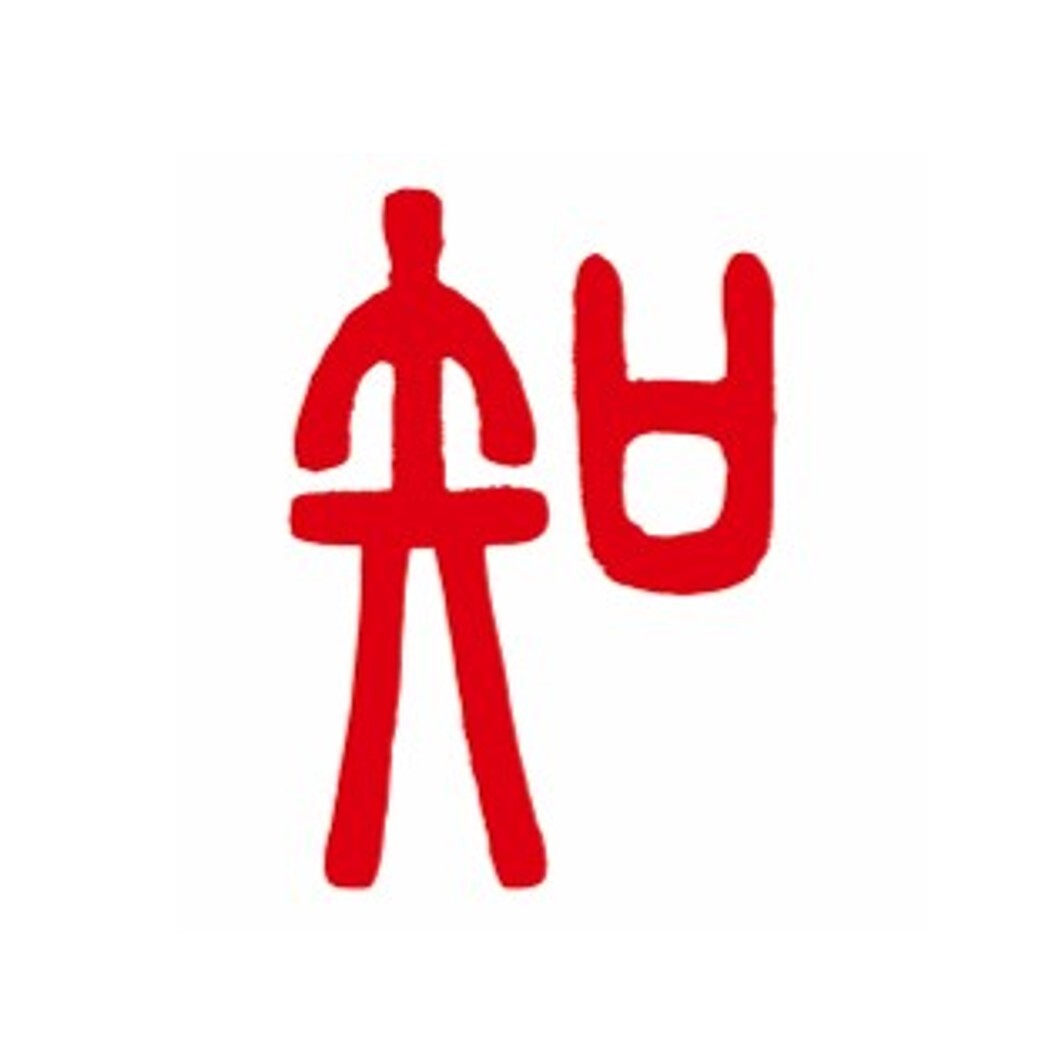
執筆者プロフィール
小林 倫太朗
バンガロール在住の20代リサーチャー。インドで日々精進中。インドコーヒーとクラフトビールを開拓中。Z世代目線からみたインドを発信していきたい。
-

編集者プロフィール
高浜 理沙
Global Market Surferのサイトづくりを担当。
 Global Market Surfer
Global Market Surfer CLP
CLP